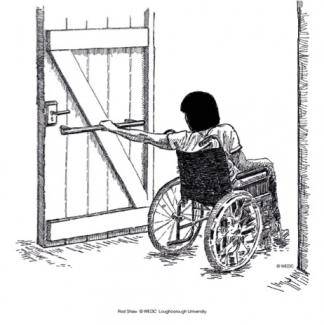Handle

© Hazel Jones and Bob Reed. 2005
Special attention to handles will facilitate opening, as well as grabbing, lifting, and pushing doors or windows for women and men with disabilities, and will equally benefit older people and children.

©Julie Smith
Chose handles that are easy to grab.
As shown in the above drawing, doorknobs or cylindrical handle are difficult to grip and turn. They should be avoided.
Doorhandles should be positioned at a height between 80-90 cm to be easy to use for wheelchair users. On a sliding door, an excellent pull handle is the "D" pull handle, as shown in the drawing below together with other easy to grip handles.

© US Ministry of Justice
Sources
Jones, H and Reed, B. Water and Sanitation for disabled people. Designing services to improve accessibility, WEDC Loughborough University, 2005.
Americans with Disability Act. Checklist for emergency shelters, 2007.